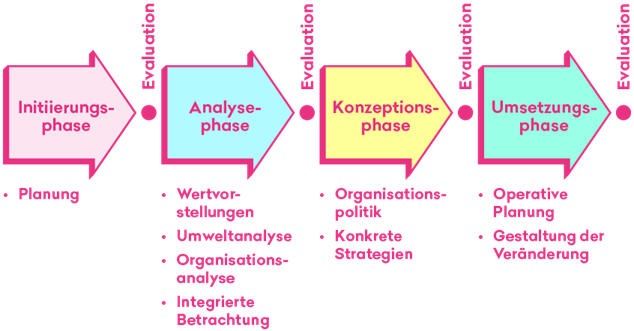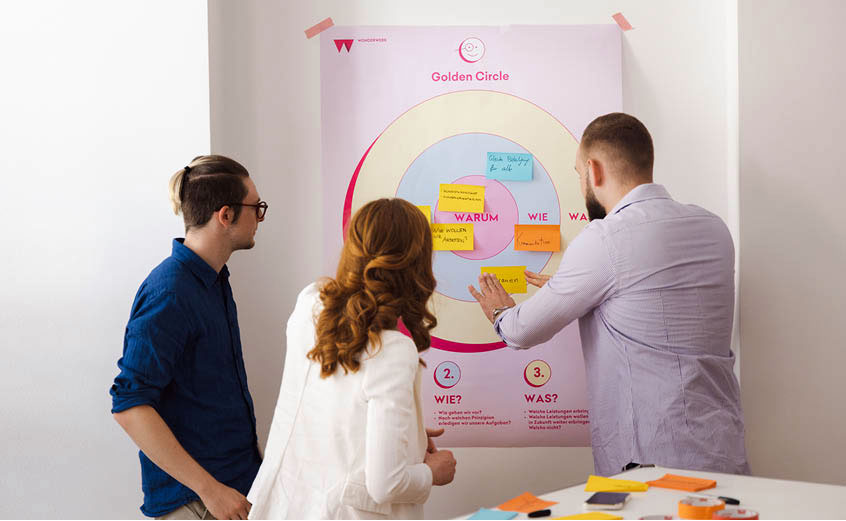Strategy development – models, methods and phases

In order for companies and organizations to remain relevant and competitive, they need strategic goals. Formulating these goals and planning their practical implementation is the task of strategy development and, as such, one of the core tasks of top management.
We show how strategy development works in companies and organizations, which models those responsible can use as a guide, and which phases a typical strategy process goes through. In addition, we take a look at different types of strategies (e.g., corporate strategies, innovation, digitalization, and sustainability strategies).
Content
- What is strategy development?
- Why is strategic management important?
- How does strategy development work?
- Phases in the strategy development process
- Strategy development – methods
- Examples of strategies
- Agile strategy development
- Strategy development with Wonderwerk
- Growth through innovation
- Why Wonderwerk?
What is strategy development?
Strategy development is about identifying potential for success and making it effective. For this reason, strategies in companies and organizations are fundamentally based on existing resources, skills, and competencies, but at the same time take into account the (organizational) environment.
Developing strategies therefore does not just mean taking a company or organization from starting point X to destination Y. The strategy process comprises at least the following three phases:

Analysis of the current situation, taking into account the market and the (organizational) environment.

Formulation of strategic objectives based on the analysis.

Formulation and development of concrete action plans based on the objectives.
Strategy development is the responsibility of top management and is usually carried out top-down: from the top down. However, there are also agile models of strategy development (more on this later) that require significantly greater stakeholder participation.
Most successful companies and organizations develop their strategies with the help of professional strategic management consultants.
Why is strategic management important?
Strategy development is necessary because companies and organizations must constantly adapt in order to remain competitive in today’s challenging working environment. Experts have coined the term “VUCA” to describe this phenomenon:
Our modern world is volatile (V), uncertain (U), complex (C), and ambiguous (A). In order to survive in such a (business) environment, a leap in innovation every three or four years is no longer enough. When done right, strategy development is therefore a process that never ends.
Strategy development enables companies and organizations to
- master new challenges in a timely and flexible manner.
- remain capable of acting despite shortages on many levels (financial resources, human resources, energy, and raw materials).
- remain competitive in a globalized market.
- continuously optimize their services and/or offerings.
- meet the increasing demands of their employees (e.g., for a better work-life balance or opportunities for remote work).
- fulfill social demands (e.g., in terms of sustainability management).
Leadership in transition
Ongoing strategic adaptation is the basic prerequisite for companies and organizations to survive in our modern working world. However, the large number of mass layoffs and liquidations in recent decades has shown that not all organizations are able to see this change as an opportunity.
We can therefore see that successful strategy development often requires a rethinking in the area of leadership (see Agile Working).
Strategy development vs. change management
Strategy development and change management are often mentioned in the same context, but they are not the same thing. In fact, change management is often part of strategy development:
Change management comes into play when it comes to planning and implementing a specific change. Change processes involve the active management of change and take place within a fixed time frame, while strategy development is an ongoing process that can integrate many (smaller) change processes depending on its scope and phase.
In our article on change management, you can read in detail about how change management works in companies and organizations.
How does strategy development work?
Strategy work is not detached from day-to-day operations, but rather a recurring task that runs cyclically: Only companies and organizations that continuously question the status quo can continuously optimize their structures and processes and thus adapt them to the prevailing conditions.
This process begins with a strategic analysis or diagnosis of the initial situation: Where do we currently stand in terms of
- the market or our niche (for companies)?
- our (business) environment: What trends do we see? What are the social, political, and legal framework conditions?
- Our customers: What do our current customers want? Is there a potential customer base that we are not currently reaching?
- Goal achievement: Are there any goals that we did not achieve in the last cycle? If so, what was the reason? What can we do better this time?
- Internal resources: Where do our strengths lie, what are our weaknesses?
In the classic top-down model, only management, selected executives, and, if necessary, selected stakeholders are involved in this strategic and analytical preparatory work.
Most companies and organizations also bring in specialists for strategic development to provide the urgently needed “outside perspective”.
Phases in the strategy development process
From the “current state” to lived, firmly implemented change, companies and organizations go through various phases in the strategy development process. The number of these phases and their names vary depending on the strategy model (see below) that the company or organization is following.
The following illustration is taken from the book “Strategieentwicklung kurz und klar” (Strategy Development in a Nutshell) by Gudrun Sander and Elisabeth Bauer. According to Sander/Bauer, the strategy development process can be divided into the following phases:

Initiation phase:
How do we want to develop our strategy? Who should be involved in this process?
Analysis phase:
Where do our strengths and weaknesses lie? What risks and opportunities are presented by current economic, social, political, and other developments?
Design phase:
What strategy or strategies do we need to fully utilize our resources, further develop our strengths, and avert any risks? In this phase, we formulate our short-, medium-, and long-term strategic goals, among other things.
Implementation phase:
How do we implement the necessarychanges? What specific steps are necessary for this (see also Change Management)?
Evaluation:
How can we measure the effectiveness of our strategy? This phase is about defining successfactors and qualitycriteria. Evaluation is not retrospective in strategywork, but ongoing.
Ongoing evaluation ensures flexibility
In practice, the individual phases of strategydevelopment cannot, of course, be clearly separated from one another. Ongoing evaluation also ensures thatsometimesgaps in the process become visible. For example, it maybecome apparent during the conceptionphase that not all the information required to formulate a strategy is available. In this case, the process goes back from the conception phase to the analysis phase.
Strategy development – Methods
The process of strategy development varies from company to company and from organization to organization. The approach depends, among other things, on the type of company or organization, the challenges it faces, and whether the company/organization operates in a classic top-down dynamic or an agile leadership and goal management framework.
For this reason,various methods anddifferent models for strategy development have emerged over the years, which differ depending on theperspective,goals (e.g., marketeconomy, resource, or innovationoriented), andimplementation. Thebest-known methods are those developed by Porter, Mintzberg, and the STEP analysis.
Industry structure analysis according to Porter
The industry structure analysis is based on the model developed by Michael Porter and follows a market-oriented approach. The focus is on the optimal positioning of the company/organization and a structured analysis of the respective industry. The aim is to identify attractive business areas and thereby develop competitive advantages. According to Porter, the attractiveness of an industry is determined by five forces:
(1) Threat from new competitors, (2) threatfrom substituteproducts, (3) bargainingpower of suppliers, (4) bargainingpower of customers (clients), and (5) rivalry among competitors. A detailed description of Porter’s industrystructureanalysis can be found here.
Strategy development according to Mintzberg
Strategy guru Henry Mintzberg coined the term Mintzberg strategy bridge. This is a method of strategydevelopment that focuses on managers. Mintzbergdescribes the strategyprocess as a bridge that helps companies and organizationsmove from the present to the future.
According to Mintzberg, there are 7 perspectives that managers musttake in order to make informeddecisions about the strategicdirection of a company/organization: The view …
1. Back: Where do we come from? Which strategies have proved successful so far, and which have not?
2. To the side: What are our competitors doing? What strategies are they pursuing?
3. From above: What does the market look like? What framework conditions (economic, sociological, political, etc.) are we dealing with? What trends are noticeable?
4. From below: What are our core markets? How do our sales figures compare to our costs? What is the status of our internal resources? Are additional resources needed to meet new challenges?
5. Looking forward: What recommended actions result from the analysis?
6. Beyond: What further developments are conceivable and how can we prepare for them? Creative methods such as Design Thinking or Lego Serious Play are very effective here.
7. Implementation: How do we review the success of our measures? How do we ensure that the changes are implemented sustainably (retrospective and ongoing evaluation)?
STEP-Analyse
The STEP analysis focuses on an essential part of strategydevelopment: It serves to analyze the macroeconomic environment of a company in order to derive long-term trends and growthopportunities. STEP analysis, also known as PEST analysis, is often an important component of corporate strategies.
In this form of strategy development, we assess the current state of a company holistically (i.e., macroeconomically) and take both internal and external factors into account. A detailed description of the STEP or PEST analysis can be found here.
For a quick overview, we have briefly summarized the four dimensions that are taken into account in the analysis of the company environment:
1. Socio-cultural influences (e.g., lifestyle, valuesystem, incomedistribution, demographic aspects, and educationlevel)
2. Technological factors (e.g., new opportunities in research and development, potential of digitalization, innovative processes, and shortened or extended productlifecycles)
3. Economic influences (e.g., economic growth or inflation, unemployment, economic cycles, and exchange rates)
4. Political aspects (e.g., internal and external compliance requirements, government subsidy programs, and global political conditions such as trade barriers or the stability or instability of certain countries)
Examples of strategies
It is no coincidence that most large companies and organizations build up in-house expertise in strategy development. Companies operating in highly volatile industries often even have their own department for corporate development and strategic planning. All strategic threads come together in what is known as business development:
In addition to the ongoing evaluation and optimization of the overarching corporate strategy, the company/organization must also continuously develop in terms of digitalization, innovation management, and sustainability. Employee development is also a matter of strategic planning and is closely related to approaches such as New Work and programs to promote intrapreneurship.
Corporate strategy
The corporate strategy is a market-oriented strategy that is designed for the long term and aims to ensure that the corporate goals are achieved. Every corporate strategy begins with a definition of the company’s purpose: What is the vision, what is the mission statement of the company? Who are we, where do we come from, where do we want to go? What are our core businesses? Who are our most important customers?
While corporate goals are often formulated in rather abstract terms (e.g., increasing market share or customer satisfaction), it is the task of corporate strategy to break down the overarching goal(s) into several smaller sub-goals. We therefore define which milestones we want to achieve by WHEN and HOW we want to achieve them.
The core of a successful corporate strategy is the formulation of the unique selling point or USP (Unique Selling Point), the positioning in the market, and the analysis/definition of the central customer benefit.
Digitalisation strategy
The digital or digitization strategy expands the corporate strategy to include the digital component. More specifically, it describes how the corporate goals can/should be achieved taking digital opportunities into account and analyzes how the opportunities offered by digitization can be translated into competitive advantages. Another aspect of the digital strategy is to anticipate, prepare, and help shape the ongoing digital transformation throughout the company.
A successful digital strategy requires ongoing evaluation and adaptation to the rapidly changing market and technical framework conditions. More information on digitization strategies can be found here.
Innovation strategy
The innovation strategy ensures that companies and organizations remain successful in the long term (sustainably) and are able to not only defend their market share or effectiveness, but also increase it in the long term. This is achieved by identifying necessary innovations in the course of strategy development: There is an ongoing comparison between the current products or the current service portfolio and the current business model with the internal and external framework conditions.
If optimization potential emerges in the course of these analyses, the innovation process is set in motion. The innovation strategy is directly dependent on the corporate strategy, as it contributes significantly to the achievement of the corporate goals.
There is also an ongoing comparison with other sub-strategies of the company/organization (e.g., with the marketing strategy). More information on the topic of innovation strategies can be found here.
Sustainability strategy
The sustainability strategy encompasses all methods and instruments for sustainable corporate development. In this context, “sustainable” means that (market) economic decisions must always be made against the backdrop of ecological and social responsibility. Since many companies and organizations have to break new ground in order to reconcile growth and sustainability, sustainability strategies are closely linked to innovation strategies.
Against the backdrop of climate change, rapid biodiversity loss, and an increasingly polluted environment, societal demands for sustainable corporate management are growing louder.
Companies and organizations that fail to meet these challenges will lose their competitive edge in the long run. Examples of successful sustainability strategies from well-known companies can be found here.
Agile strategy development
While classic models of strategy development follow a top-down approach in which goals are set by management, agile strategy development offers a flexible alternative: In an agile leadership and goal management framework such as OKR (Objectives and Key Results), strategy development takes place using agile methods (e.g., Scrum, Design Thinking, or Kanban).
The strategic goals are broken down into clearly defined stages and individual steps, each of which is implemented, evaluated, and reflected upon. This allows for corrections and adjustments at every level of the strategy development process.
Companies and organizations that establish more flexible structures as part of an agile transformation can adapt much more quickly to changing conditions and navigate better through a (business) environment characterized by uncertainty and insecurity.
Strategy development with Wonderwerk

Strategy work is tailor-made work. (Corporate) strategies that are not exactly tailored to your market environment, your business model, your corporate culture, and your value chain will not lead to long-term success. Wonderwerk Consulting provides you with the urgently needed outside perspective and works with you to define concrete objectives from which we derive concrete measures and initiatives.
We have been successfully supporting change processes in companies and organizations for years and are specialists in the process behind the strategy: We not only know in theory how strategic development works, but are also familiar with all the practical hurdles that stand in the way of sustainable change in most organizations.
We support you in,
- developing a long-term corporate strategy that involves managers, employees, customers, and stakeholders.
- developing a digitalization strategy tailored to your specific challenges.
- developing new business models that either expand your service portfolio or lead to the development of new lines of business.
- targeting innovations and their sustainable integration into both your corporate structure and culture.
- developing a sustainability strategy that fits your company/organization.
Growth through innovation
Wonderwerk is your expert for innovation management and will be happy to support you in breaking new ground. It is important to us to find the golden mean between easily planable scenarios and strategic goals that are characterized by high uncertainty. In this way, we create a balance between stability and agility.
Why Wonderwerk?
Because we are at your side from start to finish. On request, we can accompany you from the initial general brainstorming session through planning and implementation to firmly established and proven strategy work. We support you in formulating your goals in a realistic and concrete manner and work with you to develop a suitable framework for strategic planning and implementation: That’s what we do, and we do it with passion!
Contact
Anna-Maria Hausdorf
anna-maria.hausdorf@wonderwerk.com
Book your free consultation now!
Our strategy development trainings

Agile strategy work

New Leadership

Agile methods

Trendmanagement







